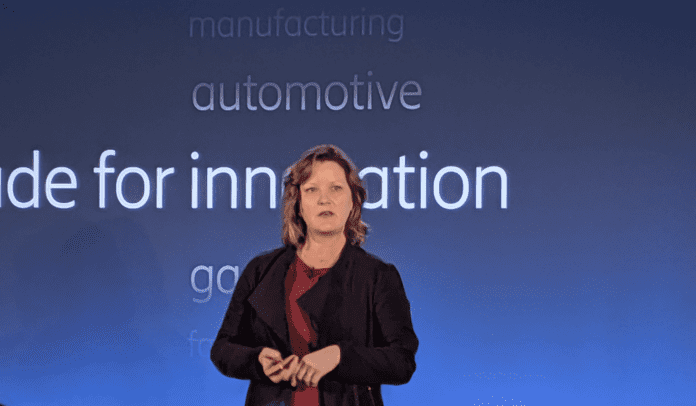Technologists and industrialists have been at cross purposes in their attempts to make industrial IoT stick, according to Ericsson. The telecoms sector, pushing various forms of cellular connectivity as a springboard for industrial change, must review its sales patter, the company said. More than this, it needs to go beyond the tech-talk to ‘walk the industrial walk’ when pitching to new prospects about the promise of industrial networking.
Mobile network operators (MNOs), as Ericsson preferred sales channel, should also seek better ways to reveal to enterprises the business value that IoT technologies can bring. That was the message from the Swedish vendor at a “pre-MWC” briefing in London at the end of last week.
“Do you think [enterprises] ask about RAN, or anything like that? No. Actually, it scares them,” said Kiva Allgood, head of IoT and new business at Ericsson. “We have to figure out how to make cellular an option [for enterprises] – how to make it easier for them. That’s the mission… We need to bring a slightly different language.”
Allgood restated the company line that Ericsson will look to sell to enterprises in partnership with its traditional operator customers, rather than going direct – which was the hard-line message from rival firm Nokia for most of 2019, although it appears to have embraced a more cautious tone in recent months.

“We still go to market through though communications service providers,” said Allgood, later clarifying, to clear up any doubt, that the term ‘service provider’ means operator / carrier for Ericsson. “But we have to listen to enterprise use cases. And a lot of the a-ha moments in the last year have been where we were not intimate, necessarily, with what the operator or the manufacturer has wanted to do.”
The ecosystem, on the vendor side, at least, must be better attuned to the minutiae of enterprise operations, she suggested.
Ericsson has 100 private cellular networks, it stated in its slide deck at the event, highlighting deployments with Mercedes-Benz and Telefónica, and a new deal with Telenor in Sweden to resell its Industry Connect private LTE bundle to industrial companies. Last week, Nokia claimed 130, with a rush in the final quarter of 2019.
In an aside, in London, Ericsson said the number should be considered a guide, and that deployments so far have all been with operators, simply because they remain, for the time being, the default license holders for radio spectrum in all markets. But Ericsson’s position, the company said, is to go via operators, as it can.
It recruited Telefonica for the private networking contract with Mercedes-Benz in Germany, it might be noted. At the same time, its approach is pragmatic, preferring to partner with old familiars, but taking business where it can get it. (Which is closer to the revised Nokia line on the subject.)
Allgood said enterprises want digital change to drive business and sustainability, and even to enter new markets. The inner-workings of the various technologies required for digital change are less interesting than the change itself. “They don’t ask for technical solutions,” she said.
“They want to know how to save money, how to make money, and how to figure things out. That’s where their lens is. They want to change, but their mindset is on outcomes, and value. We are transitioning from proof-of-concept to proof-of-value – to measure the outcomes. We are starting to see that in the work we are doing.”
Internally, Ericsson is shifting its working habits to bring enterprises’ IoT networking requirements into its own development cycles, and across its business teams.
“We are building those requirements into product planning, so we are part of the funnel, and so those services are part of the original product set. That’s important for enterprises – they can feel like an afterthought to our MNO partners. We are trying to bring those requirements to the forefront every time we release a product.”
Allgood added: “We have to work more tightly with the MNOs… Some are super innovative – some have strengths to address enterprise needs. We have to figure out how to take the same type of go-to-market and innovation, and bring that insight to enterprises. We have to align and get over that obstacle.”
She promoted Ericsson’s IoT Accelerator network, counting 35 servce provider partners for global cellular connectivity for IoT use cases for 5,000 enterprises. “[It is the] best secret out there, a dedicated global IoT network,” she said, making the point IoT manufaacturers can optimize devices for local deployments anywhere. “It is the only product in market hat can do that today.”

Ericsson listed some of its enterprise customers. These include Stanley Black & Decker, Volvo, Borgward, Fuelics, and Grundfos, among others. It also listed various of its Industry 4.0 partners, including ABB, Altran, Atlas Copco, Epiroc, Fujitsu, Hexagon, Microsoft, and PTC, among others.
She also showed a chart with Ericsson’s own projected hockey-stick growth for cellular IoT solutions in the period to 2025 (see image).
“[There is a] question about why IoT has not been realized, yet, and a lot of it comes down to fact it is still a very fragmented market. One of big goals for Ericsson is to figure out how how we make cellular an option… [and] to address fragmentation, testing, onboarding, certification… and how to bring teams together to make it easier, to make sure these numbers become reality faster.”

